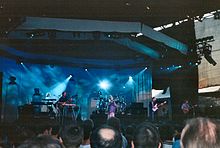In March 1996, Yes performed three live shows at the Fremont Theater in San Luis Obispo, California which were recorded and released, along with the new studio tracks, that October on CMC International Records as the Keys to Ascension album, which peaked at number 48 in the UK and number 99 in the US. A same-titled live video of the shows was also released that year.
Yes continued to record new tracks in the studio, drawing some material written around the time of the XYZ project. At one point the new songs were to be released as a studio album, but commercial considerations meant that the new tracks were eventually packaged with the remainder of the 1996 San Luis Obispo shows in November 1997 on Keys to Ascension 2. The record managed to reach number 62 in the UK, but failed to chart in the US. Disgruntled at the way a potential studio album had been sacrificed in favour of the Keys to Ascension releases (as well as the way in which a Yes tour was being arranged without his input or agreement), Wakeman left the group again. (The studio material from both albums would eventually be compiled and re-released without the live tracks onto a single CD, 2001's Keystudio.)
With Yes in disarray again, Squire turned to Billy Sherwood (by now the band's engineer) for help. Both men had been working on a side project called Conspiracy and reworked existing demos and recordings from there to turn them into Yes songs, and also worked on new material with Anderson and White. (Howe's involvement at this stage was minimal, mainly taking place towards the end of the sessions.) Sherwood's integral involvement with the writing, production, and performance of the music led to his finally joining Yes as a full member (taking on the role of harmony singer, keyboardist and second guitarist).

Niciun comentariu:
Trimiteți un comentariu